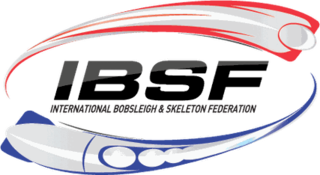
Bobsleigh or bobsled is a winter sport in which teams of 2 to 4 athletes make timed runs down narrow, twisting, banked, iced tracks in a gravity-powered sleigh. International bobsleigh competitions are governed by the International Bobsleigh and Skeleton Federation.

The 1948 Winter Olympics, officially known as the V Olympic Winter Games and commonly known as St. Moritz 1948, were a winter multi-sport event held from 30 January to 8 February 1948 in St. Moritz, Switzerland. The Games were the first to be celebrated after World War II; it had been twelve years since the last Winter Games in 1936.

The 1928 Winter Olympics, officially known as the II Olympic Winter Games and commonly known as St. Moritz 1928, were an international winter multi-sport event that was celebrated from 11 to 19 February 1928 in St. Moritz, Switzerland.

Skeleton is a winter sliding sport in which a person rides a small sled, known as a skeleton bobsled, down a frozen track while lying face down and head-first. The sport and the sled may have been named from the bony appearance of the sled.

Sledding, sledging or sleighing is a winter sport typically carried out in a prone or seated position on a vehicle generically known as a sled, a sledge (British), or a sleigh. It is the basis of three Olympic sports: luge, skeleton and bobsledding. When practised on sand, it is known as a form of sandboarding. In Russia sledges are used for maritime activities including fishing and commuting from island to island on ice.

The Cresta Run is a natural ice track in eastern-Switzerland used for skeleton-toboggan racing. Located in the winter sports town of St. Moritz, the 1.2125 km (0.753 mi) run is one of the few in the world dedicated entirely to skeleton. It was built in 1884 near the hamlet of Cresta in the municipality of Celerina/Schlarigna by the Outdoor Amusement Committee of the Kulm Hotel and the people of St. Moritz. It has continued as a partnership to this day between the St. Moritz Tobogganing Club (SMTC), founded in 1887, and the people of St. Moritz.
These are the results of the men's skeleton competition at the 1928 Winter Olympics in St. Moritz. At that time the sport was called cresta, and St. Moritz had the most famous Cresta Run, dating to 1884. In many locations the sport was referred to as tobogganing during these and the 1948 Games. The competition took place on the Cresta Run and medals were awarded after a total of three runs down the course.

Skeleton is a winter sport featured in the Winter Olympics where the competitor rides head-first and prone on a flat sled. It is normally run on an ice track that allows the sled to gain speed by gravity. It was first contested at the 1928 Winter Olympics in St. Moritz and again in 1948 Winter Olympics, after which it was discontinued as an Olympic sport.

Switzerland was the host nation for the 1948 Winter Olympics in St. Moritz. It was the second time that Switzerland had hosted the Winter Games, after the 1928 Winter Olympics, also in St. Moritz.

The International Bobsleigh and Skeleton Federation (IBSF) is the international sports federation for the sliding sports of Bobsleigh and Skeleton. It was founded on 23 November 1923 by the delegates of Great Britain, France, Switzerland, Canada, and the United States at the meeting of their first International Congress in Paris, France. In June 2015, it announced a name change from FIBT to IBSF. The federation's headquarters are in Lausanne, Switzerland.
The FIBT World Championships 1982 took place in St. Moritz, Switzerland for the record fourteenth time. The Swiss city had hosted the event previously in 1931 (Four-man), 1935 (Four-man), 1937 (Four-man), 1938 (Two-man), 1939 (Two-man), 1947, 1955, 1957, 1959, 1965, 1970, 1974, and 1977. The skeleton event debuted at the championships after being held in St. Moritz at the 1928 and 1948 Winter Olympics and it marked the first time the event took place on the actual bobsleigh track and not on the Cresta Run.

John Rutherford Heaton was an American bobsledder and skeleton racer who competed from the late 1920s to the late 1940s.
Wilbur Lee Martin was an American skeleton racer who competed in the late 1940s. He finished fourth in the men's skeleton event at the 1948 Winter Olympics in St. Moritz.
Lieutenant colonel Sir James Stuart Coats, 3rd Baronet MC was a British skeleton racer who competed in the late 1940s. He finished seventh in the men's skeleton event at the 1948 Winter Olympics in St. Moritz. He served as President of the St. Moritz Tobogganing Club from 1954 to 1956.
Farchild Maccarthy was born in Muskegon, Michigan was an American skeleton racer who competed in the late 1940s. He finished eighth in the men's skeleton event at the 1948 Winter Olympics in St. Moritz.
For the 1928 Winter Olympics in St. Moritz, Switzerland, a total of five sports venues were used. The main stadium hosted the figure skating, ice hockey, and speed skating events. Skeleton was first held at the Cresta Run. Bobsleigh was held at the bob run. St. Moritz itself served as cross-country skiing venue and the cross-country part of the Nordic combined event. Weather gave two events run at these games problems, creating the largest margin of victory in Olympic history for one and the cancellation of the other.
For the 1948 Winter Olympics in St. Moritz, Switzerland, a total of eight sports venues were used. The five venues used for the 1928 Winter Olympics were reused for these games. Three new venues were added for alpine skiing which had been added to the Winter Olympics program twelve years earlier in Garmisch-Partenkirchen, Germany. As of 2015, the bob run continues to be used for bobsleigh and the Cresta Run for skeleton while alpine skiing remains popular in St. Moritz.










